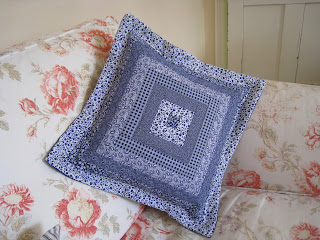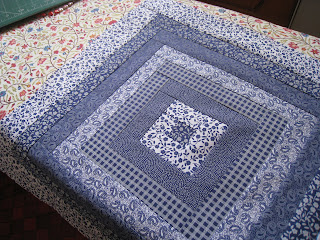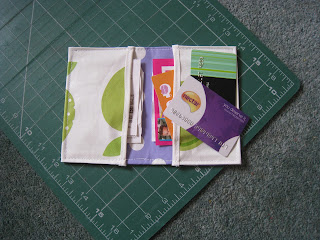Welcome back after drinking your coffee and your break. Now let the real fun begin, we are going to start sewing in earnest, but of course, you know that we are not going straight to the machine, switch on your iron, get the instructions to hand and collect a couple of scraps of the fabric which you have cut out.
Switch on your sewing machine, make sure you are working in good light and try some simple running stitches on your fabric to make sure that the tension of your stitches is correct, adjust it as necessary. You will often see that a pattern asks you to stay stitch the neck edges, this is just a line of running stitches on a single piece of fabric which stabilises the fabric and ensures that you do not stretch or distort it when you are working with it.
The dress I am making has four pleats on the front, we have marked their place with tailor's tacking, pin together the marking - I place a pin through one piece of tacking and then check the other side to ensure it lines up. Now depending on how confident a sewer you are, you can tack the pleats together or pin them. When you do pleats, start from the centre and work towards the outside, working equally in each direction, so one right side, then one left side and so on.
Next it's over to ironing board, press the pleats to the centre, always to the centre... same goes with darts and whether it is the front or the back of your piece, they always go to the middle. Sew them down about 1/4" from the raw edge.
Now I am to sew up the back to the point where I will insert the zip, you will see a little notch, make sure you match up the notches on both sides, this will ensure that your work is even and accurate. Press the seam open, you will notice that I tell you to press all your seams open, this ensures that your work is even and you do not end up chunky lumps that tell everyone that your garment is homemade rather than a one off couture piece.
Next come the shoulders, zap across with your running stitch, and repeat this down the sides, remembering to match up those notches accurately. Cripes it looks like a proper little dress now, you are on your way to working at an atelier in Paris... but there is more to come.
I don't have an overlocker, but I like my seams to look neat and tidy, so I am going to fold the sewn seam allowance in and sew down them too.
Right, now for the bit that you have been dreading... the Zip! I am going to let you into a secret, they are really easy and if you make a mistake you can always undo it and nobody dies, really you can do no damage inserting a zip.
Remember how you pressed the back seam open, pin the left hand side, flush with the teeth of the zip, keeping the edges of the fabric together, pin up the right side so that it covers the zip teeth. Tack the zip in place, and then fit your machine with the zipper foot and slowly sew it into place... now wasn't that easy?
We are almost there, let's get going with the bias binding which is going to ensure we get a great finish on the neck. Open out one side of the tape and start pinning, with right sides facing to the neckline along the folded line of the tape.. hmmm it's a bit tricky because it is curved so we are going to ease it - remember we did this with the glasses case - we need to cut small triangles into the neckline which means that it will sit more easily and the fabric will curve with the bias binding. Sew the bias binding onto the neckline.
Out with your iron again to get a sharp edge around the neck, and pin the other side of the bias binding to the reverse side of your fabric, Now it is back to the hand stitching, to slip stitch this into place, remember to pick up only one or two threads so that your stitches do not show. Carefully press the binding into place. Next repeat the bias binding process around the sleeves just as we have done with the neck.
Finally we have the hem, there are a variety of ways of doing this, from simply rolling over 1/4" and pressing, followed by 1/2" and just top stitching it (yes, I know it's running stitch, you know it's running stitch but calling it top stitching makes it sound couture!) Or we could slip stitch it into place... or we could have real fun by using a stitch on your sewing machine called blind hemming stitch which places a tiny vertical stitch which is seen externally and is almost invisible, hence the name.
One last press with the iron and find a small child to model it for you.
So, what next to cover on sewing 101, sleeves or buttonholes?
Right over to
Handmade Monday to see what everyone has been up to this week.
And finally congratulations to Handbags by Helen, who is the winner of the log cabin cushion giveway... I will be in touch by mail to get her address and be off to the PO.






















































